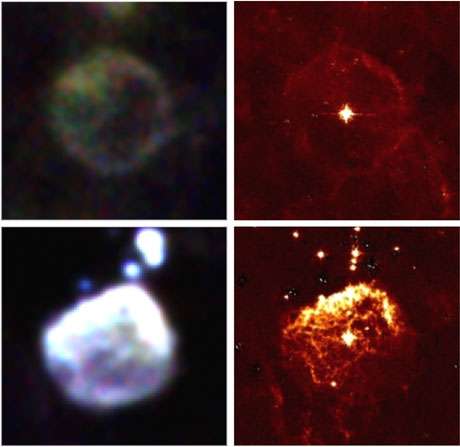Pushy neighbors force stellar twins to diverge

(Phys.org) —Much like an environment influences people, so too do cosmic communities affect even giant dazzling stars: Peering deep into the Milky Way galaxy's center from a high-flying observatory, Cornell astronomers have discovered identical, rare stars whose diverging dusty and gaseous garb are strictly influenced by an intrusive cluster of neighbors.
Scarce, short-lived, hyperbright stars called luminous blue variables – a million times brighter than our own sun – inhabit the center of the Milky Way galaxy, 25,000 light years from Earth, which loiters in the Milky Way boonies. Astronomers have found two luminous blue variable (LBV) stars – one called the Pistol star and the other named LBV3 – to be identical. As stars, they are themselves neighbors, but their dusty, gaseous outer cloaks (outer nebulae) are substantially different.
Both are the same size and have identical gas-to-dust mass ratios and total gas masses, according to a paper published April 2 in the Astrophysical Journal.
"Think identical stars with different shells. We found that the nebula of the insanely bright Pistol star is warped, while the LBV3 is an almost-perfect spherical shell," says Ryan M. Lau, Cornell doctoral candidate in the field of astronomy. "These LBVs are rare stars, and we only know about 12 that exist, but they are surrounded by these dust- and gas-filled nebulae that look different."
Both the Pistol star and LBV3 formed under similar conditions, according to the researchers. Dust in the Pistol star's nebula is brilliant, compressed, externally heated and ionized, thanks to its proximity to neighbors in the Quintuplet Cluster.
By contrast, the LBV3 nebula is dim, symmetrical and cooler. LBV3's nebula progresses in an outward fashion naturally, thanks to its relative lack of proximity to anything.
"The initial attention draw to the Pistol star was its high luminosity, [but] the nebulae around it and its sister star [LBV3] have turned out to be quite interesting. While the Pistol star is a member of the Quintuplet Cluster – although on the outskirts of the cluster – it is about six light-years away from the cluster's center. That's about 1.5 times the distance from our solar system to the nearest star," says senior author Terry Herter, Cornell professor of astronomy and department chair. "It's impressive that even at this distance, the rest of the Quintuplet Cluster exerts a large influence on the Pistol nebula."
In optical ground telescopes, cosmic dust obfuscates both stars. To cut through the cosmic grime, astronomers need a midrange infrared telescope.
To explore far above atmospheric waters, the astronomers examined the inner galaxy July 1, 2013, from SOFIA (the Stratospheric Observatory for Infrared Astronomy), a modified Boeing 747 SP that climbs to 43,000 feet. To spy these super luminous objects, the group used FORCAST, the Faint Object InfraRed Camera for the SOFIA Telescope, developed at Cornell.
The research, "Nature Versus Nurture: Luminous Blue Variable Nebulae in and Near Massive Stellar Clusters at the Galactic Center," was also co-authored by Mark Morris, University of California, Los Angeles, and Joe Adams, SOFIA Science Center, NASA Ames Research Center.
NASA and the Universities Space Research Association funded the research. Lau was previously an intern at Cornell, through the National Science Foundation-funded Research Experiences for Undergraduates program, while an undergraduate at Reed College.
More information: "Nature Versus Nurture: Luminous Blue Variable Nebulae in and near Massive Stellar Clusters at the Galactic Center." Ryan M. Lau, Terry L. Herter, Mark R. Morris, Joseph D. Adams. arXiv:1403.5298 [astro-ph.GA] arxiv.org/abs/1403.5298
Journal information: Astrophysical Journal , arXiv
Provided by Cornell University




















